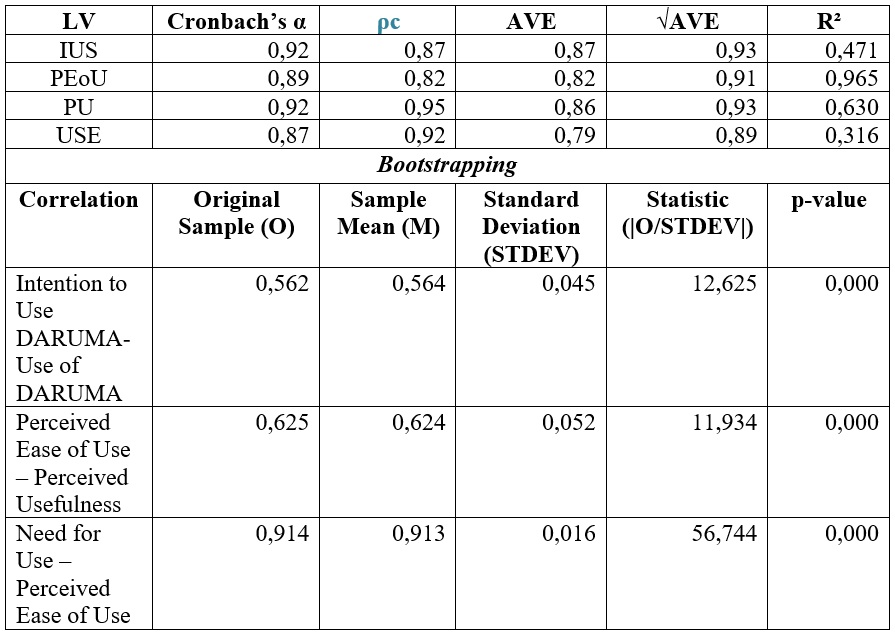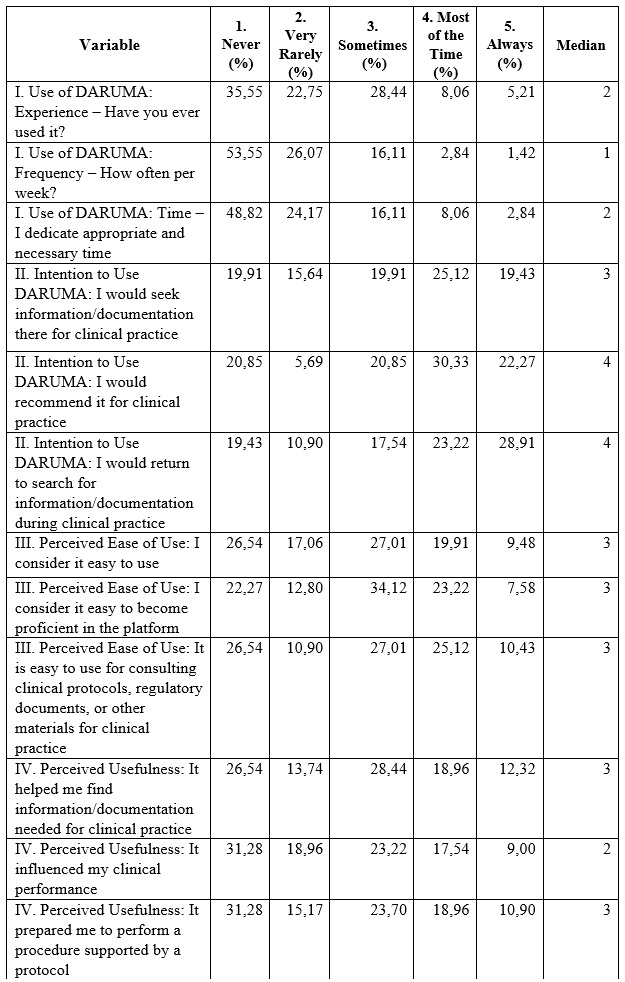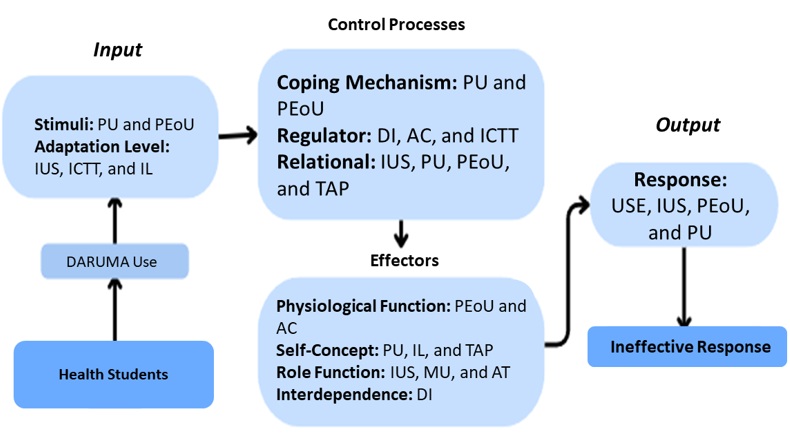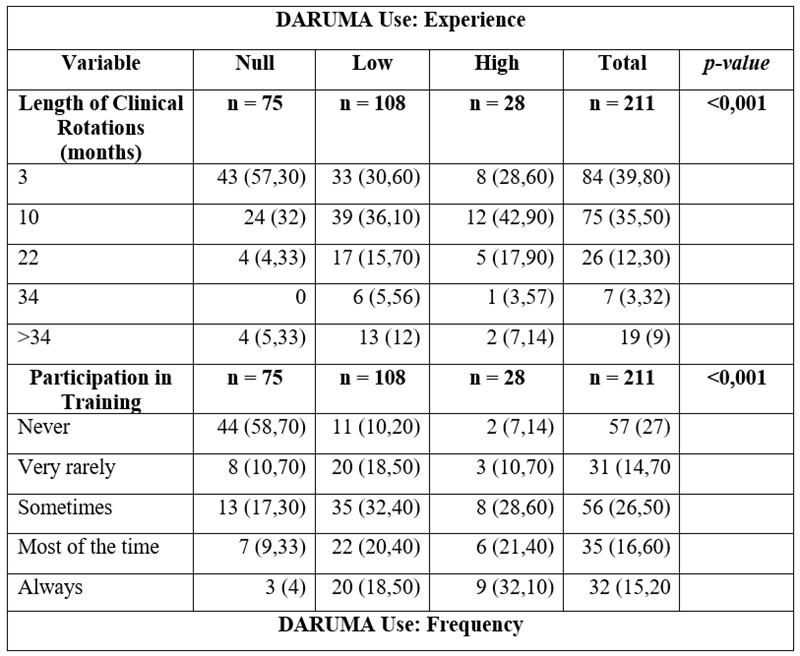Introduction
Digital transformation in the healthcare field has revolutionized both access to clinical information and its management. Document management software, such as DARUMA (1), plays a crucial role in process standardization and patient safety enhancement. These platforms not only enable the consultation and registration of clinical protocols but also ensure that procedures are consistent and evidence-based. However, effective adoption depends on several factors that may vary at both individual and institutional levels, impacting their implementation in clinical settings.
Within the framework of institutional accreditation, the implementation of DARUMA has been essential in strengthening the standardization of clinical processes; however, the factors that determine its effective use by healthcare trainees have not yet been studied.
According to a 2019 report by the World Health Organization, unsafe practices in healthcare result in 2.6 million deaths annually in low- and middle-income countries (2). Platforms like DARUMA help mitigate these risks by facilitating adherence to established protocols and improving the quality of care. Moreover, the use of technology for document management aligns with the Sustainable Development Goals (3), specifically Goal 3 (4), which aims to ensure access to essential and safe health services.
Standardization of care processes and accreditation of healthcare institutions are fundamental, as these practices improve service organization and quality, increase user confidence, and reduce costs associated with poor quality. In Colombia, the accreditation of healthcare institutions is regulated by manuals developed by the Ministry of Health, the Pan American Health Organization, and Decree 1011 of 2006 (5), which established the Mandatory Quality Assurance System. Healthcare providers seeking high-quality accreditation have followed these guidelines and obtained institutional accreditation, which recognizes best practices and quality care processes in institutions—but also challenges them to maintain and improve these standards.
In the present study, the Technology Acceptance Model (TAM) was used as a framework to assess how students perceive the usefulness and ease of use of the DARUMA platform in their clinical training (6). According to this model, the adoption of new technologies largely depends on these perceptions, which directly influence the aforementioned factors. In this study’s context, the analysis focused on how health sciences students evaluate these features when using the platform during their clinical rotations.
Additionally, Roy’s Adaptation Model (7) was applied, considering students as adaptive systems interacting with their environment. In this case, the DARUMA platform represents a new stimulus requiring students to adjust and adapt their behavior to meet the expectations of standardized and safe care. The study explores how students respond to this environment and the factors that facilitate or hinder their adaptation.
Moreover, previous studies on the adoption of document management technologies in clinical settings (8,9) have shown that training, adequate access to technology, and institutional support are key factors. This article analyzes these specific factors in the context of the Hospital Universitario del Valle, to provide recommendations that contribute to the continuous improvement of the DARUMA platform and its integration into the academic training of future healthcare professionals.
Objective
To identify the individual and institutional factors related to the use of the DARUMA platform by health sciences students during their clinical rotations at a healthcare provider institution (IPS) in 2024.
Specific Objectives
-
To characterize the student
population engaged in clinical rotations at an IPS in 2024, included in the
study.
-
To measure the use of
the DARUMA platform by health sciences students during their clinical
rotations.
-
To describe the
individual and institutional factors that either facilitate or hinder the use
of the DARUMA platform by health sciences students at the IPS.
Methods
Study Design
The present study is quantitative in nature and employs a cross-sectional design. It is considered quantitative because it focuses on the numerical measurement and statistical analysis of variables to address the research question. A structured questionnaire with Likert scales was used to collect data, and statistical models were applied to analyze the relationships between variables.
Furthermore, it is cross-sectional as data were collected at a single point in time, providing a snapshot of the variables of interest without longitudinal follow-up. This approach allows for the identification of relationships and patterns at a specific moment but does not establish causal associations.
Context
The study was conducted in a third-level healthcare provider institution (IPS) during the first semester of 2024, where students from various academic programs carried out their clinical rotations. These students, from higher education institutions with active agreements, actively participated in healthcare delivery under the supervision of faculty members.
Data collection began with the presentation of the project to the Assistance-Teaching Committee and received support from both the higher education institutions and the Hospital Universitario del Valle. Subsequently, various hybrid approaches were employed to engage with students, including phone calls, emails, videoconference appointments (via Google Meet), and in-person meetings held in classrooms between March 4 and April 26, 2024.
Participants
The inclusion criteria for study participants were as follows:
-
Students
from higher education, technological, or technical institutions with active
teaching-service agreements with the IPS.
-
Students
engaged in clinical practice, understood as a supervised learning process
focused on patient care.
-
Students
who had attended two or more clinical rotations or had completed the induction
process.
The exclusion criteria applied were:
The information was provided by the IPS through lists of students with scheduled clinical rotations during the data collection period. Additionally, clinical practice coordinators from each higher education institution were contacted to facilitate access for data collection.
Variables
The study variables were evaluated using a structural model that includes both observable and latent variables. The observable variables are related to the defined constructs, such as use of the DARUMA platform (USE), measured by frequency, duration, and depth of use, and intention to use DARUMA (IUS), which reflects users’ willingness and future plans to utilize the tool.
Perceived ease of use (PEoU) and perceived usefulness (PU) were also measured, assessing how easily and effectively DARUMA is perceived to function in academic contexts. Additional factors considered include the need for use (NU), accessibility (AC), dissemination (DI), academic training (AT), and teacher attitude and preparedness (TAP), which explore the educational environment and faculty characteristics related to the use of the platform.
Sociodemographic variables were also included in the study, such as: year of enrollment, current academic semester, educational program, age, sex, time since the beginning of clinical rotations, and level of education.
Data Source
The variables were assessed using structured questionnaires based on Likert-type scales, which measure the degree of agreement or disagreement with various statements related to the use and perception of the platform. The instruments were administered electronically via online forms, ensuring an efficient data collection process. Participants completed the questionnaires in a secure and accessible digital environment.
The use of a structural model was justified by the need to understand both causal and correlational relationships between observable and latent variables. This model not only identifies which variables directly influence the use of the DARUMA platform but also explains how they are interrelated. Furthermore, this approach was chosen to assess the validity and reliability of the constructs and to analyze the proportion of variance explained by the relationships among variables. The structural model was evaluated using the following parameters:
-
Cronbach’s alpha (α) to assess internal
consistency of the scales, with values above 0.8 indicating high consistency.
-
Composite Reliability (ρc) to measure the
reliability of latent constructs, with values near 1 indicating high
reliability.
-
Average Variance Extracted (AVE), which measures the variance captured by the
latent constructs, with values above 0.7 indicating good convergent validity.
-
The square root of the AVE compared to the inter-construct correlations to
evaluate discriminant validity.
-
Bootstrapping to estimate the precision of the relationships among variables.
Biases
Response bias. Students may provide biased or inaccurate responses in the surveys due to lack of sincerity, memory limitations, or other reasons. Given that the implemented instrument used Likert-type questions, the following types of bias may have occurred:
-
Lack of
sincerity: Students may not have been fully honest in their responses. They may
have attempted to provide answers they believed were socially acceptable or
that they thought the researcher wanted to hear, rather than expressing their
true thoughts or feelings.
-
Other
factors: Various additional reasons may have influenced students’ responses.
For example, they may have misunderstood the questions, felt pressured by the
survey context, or simply lacked interest in providing accurate answers.
To control for these biases, students were approached in advance, followed by communication with the clinical practice coordinators. The importance of the study was explained, along with the need for honest participation. Informed consent and the confidentiality of the provided data were also clearly communicated.
Sample Size
The initial study population consisted of 887 students at the beginning of data collection. The final sample size was calculated using the finite population formula, considering a 95% confidence level and a margin of error of 5.75%. The resulting calculation yielded a randomly selected sample of 211 students. This sampling approach aimed to ensure adequate representation of the different student groups and to enable more precise data analysis. Stratification was based on the type of educational institution, students’ academic programs, and other relevant factors to ensure proportional representation of each group within the sample.
Regarding the defined strata:
In terms of academic programs, students were distributed as follows:
-
Medicine:
35.5% of the sample.
-
Nursing:
12.8% of the sample.
-
Physical
Therapy: 10.4% of the sample.
-
Psychology: 10% of the sample.
-
Other
programs: including respiratory therapy, bacteriology, among others, which
represented smaller percentages.
This stratification ensured that each group of students had proportional representation according to their academic training.
Quantitative Variables
An exploratory analysis of the quantitative variables was conducted to identify data concentration and completeness, using summary measures such as the mean and median. Likewise, for the qualitative variables, data analysis followed a structured process to ensure the validity and reliability of the results:
Descriptive Analysis. Descriptive statistics were employed, including measures of central tendency such as the median. Cronbach’s alpha (α) was also applied to assess the internal consistency of the scales, with values above 0.8 considered indicative of high consistency.
Correlation Analysis. Correlation analyses were used to assess the relationships between observed and latent variables. Composite Reliability (ρc) was used to measure the reliability of latent constructs, with values close to 1 indicating high reliability. Additionally, Average Variance Extracted (AVE) was used to measure the variance captured by the latent constructs, with values greater than 0.7 considered indicative of good validity.
Reliability and Validity Analysis. The square root of the AVE was compared to the inter-construct correlations to assess convergent validity. The R² (coefficient of determination) analysis provided the proportion of variance explained by the model, while bootstrappingwas used to estimate the precision of the relationships between variables.
Statistical Methods
SPSS software was used for descriptive and correlation analyses, while SmartPLS was employed to evaluate the structural model and conduct validity testing. The study complied with both national and international ethical standards, including Resolution 008430 of 1993. Fundamental ethical principles such as respect for persons, beneficence, and justice were upheld. Confidentiality was ensured through the use of identification codes. The study was approved by the relevant ethics committees, and informed consent was obtained from all participants.
Results
Participants
A total of 211 students from various higher education institutions completed the survey.
Descriptive Data
The majority of students in clinical practice were from Universidad del Valle (60.2%), followed by Universidad Santiago de Cali (10.9%) and other institutions. Most participants (74.4%) were enrolled in public institutions. The most common academic program was Medicine (35.5%), followed by Nursing (12.8%), Physical Therapy (10.4%), and Psychology (10%).
Regarding gender, 64.9% were female and 35.1% were male. Most participants (85.3%) were undergraduate students, with 10.9% enrolled in technical programs and 3.8% in technological programs. The majority had started their clinical rotations in 2024 (39.8%) or 2023 (35.5%). The ninth (22.7%) and seventh (20.4%) semesters were the most frequently reported.
Age distribution was as follows: 39.8% were between 19 and 22 years old, and 38.4% between 23 and 26 years old. Most students (74.4%) were dedicated exclusively to studying, while 25.6% combined study with work.
Measurement Model Description
The main constructs were defined within the structural model, as represented in Figure 1.
 Figure 1.
Final
Research Model
Figure 1.
Final
Research Model
The presented model is not the result of a traditional exploratory factor analysis, but rather a Structural Equation Model (SEM). This type of model is used to examine relationships between latent variables (theoretical constructs not directly observable) and their corresponding observed variables (measurable indicators). SEM allows for the evaluation of how latent variables influence observed variables and how they relate to one another.
The latent variables were determined based on the theoretical frameworks of the Technology Acceptance Model (TAM) and Roy’s Adaptation Model, which served as the foundation for the study design. The observed variables were selected through a comprehensive review of existing literature on technology adoption in educational and clinical settings, ensuring that the indicators were relevant and valid for measuring the theoretical constructs of interest.
Latent Variables
-
Use of DARUMA (USE).
-
Intention
to Use DARUMA (IUS)
-
Perceived
Ease of Use (PEoU)
-
Perceived Usefulness
(PU)
Observed Variables
The observed variables were defined to assess specific aspects of each latent variable, using Likert-type scales in the questionnaires administered to students. These included questions related to frequency of use, perceived usefulness, perceived ease of use, among other relevant aspects for each construct.
Validity and Reliability of Measurement Scales
The validity and reliability of the constructs were ensured using a sample of 211 respondents. The indicators used—such as AVE, the square root of AVE, Cronbach’s alpha, and Composite Reliability (ρc)—demonstrated that the constructs were well-defined and reliable (Table 1). All AVE values exceeded 0.7, indicating a significant amount of variance explained by the underlying latent variables.
Table 1.
Analysis
of Reflective Latent Variables

Structural Model Evaluation
The R² values exceeded the 0.2 threshold, indicating a substantial contribution of the latent variables to the explanation of variance within the model. The goodness-of-fit (GOF) statistic was 0.71, suggesting a good fit of the model to the observed data. Additionally, the Path coefficients obtained through the bootstrapping process are detailed in Table 1. These coefficients represent the relationships between the different variables within the model and were found to be statistically significant, with p-values below 0.05. Moreover, these relationships exhibited strong correlations with one another.
Use of DARUMA in Clinical Practice
As shown in Table 2, regarding actual use, 58% of students reported that they rarely or never used the DARUMA platform. Furthermore, 79% did not use it during the past week, and 73% indicated that they do not dedicate sufficient or appropriate time to its use.
Table 2.
Key
Constructs

Roy’s Adaptation Model
Within the framework of Roy’s Adaptation Model, the interaction between the health sciences student and the technological platform DARUMA can be understood as an adaptive process that responds to various stimuli in the clinical and educational environment. Figure 2 illustrates this process, beginning with the input of stimuli, which in this case are represented by perceived usefulness (PU) and perceived ease of use (PEoU). These constitute the focal stimuli—those that directly impact the individual and demand an immediate response. In turn, the student’s level of adaptation is influenced by their intention to use (IUS), ICT training (ICTT), and information literacy (IL), which act as contextual stimuli that modulate the individual’s adaptive capacity.
 Figure 2.
Roy’s Adaptation Model for the Analysis of
DARUMA
Figure 2.
Roy’s Adaptation Model for the Analysis of
DARUMA
Once these stimuli are received, control processes are activated, which are divided into three mechanisms: coping, regulator, and interdependence. The coping mechanism reflects the strategies students use to face the technological challenge posed by DARUMA, directly influenced by perceived usefulness (PU) and perceived ease of use (PEoU). The regulator mechanism is related to internal factors such as dissemination (DI), accessibility (AC), and ICT training (ICTT); while the interdependence mechanism incorporates aspects of the social environment, such as peer and faculty support, as well as interaction with the technological platform itself.
These mechanisms influence the effectors, which correspond to the four adaptive modes described by Roy: physiological function, self-concept, role function, and interdependence. The physiological function refers to the technical and physical use of the system; self-concept encompasses the student's perception of themselves in relation to technology; role function is linked to the fulfillment of their academic and clinical responsibilities as mediated by technology; and interdependence refers to supportive relationships with other actors in the educational environment.
Ultimately, this complex process leads to an adaptive response, which may be either effective or ineffective. In this case, an ineffective response is associated with poor use of the platform, low intention to use it, or difficulties in perceiving its usefulness and ease of use. This situation highlights the need to strengthen coping resources and provide pedagogical, technological, and emotional support strategies that promote effective student adaptation to digital learning and clinical management environments.
Bivariate Analysis of DARUMA Use
According to Table 3, the data reveal that several factors influence both the frequency and the quality of students’ experience using the DARUMA platform during their clinical practice. A significant correlation was found between the length of clinical rotations and the use of DARUMA: students with longer rotations (e.g., 10 months) reported higher usage of the platform (42.9%), while those in shorter rotations (3 months) did not (57.3%).
Participation in training sessions also proved to be a key factor. Students who regularly attended these sessions reported greater platform usage experience (32.1%) and dedicated more time to it, compared to those who did not participate (58.7%).
Although the type of institution did not reach conventional statistical significance, a trend was observed whereby students from public institutions reported a higher level of experience using the platform (67.9%) compared to those from private institutions (32.1%).
Table 3.
Bivariate
Analysis

Regarding the frequency of use, differences are evident between students from public and private institutions: the former use the DARUMA platform more frequently. Academic programs also influence this frequency: a higher percentage of null use is observed among medical students (56.6%), while physical therapy students are more evenly distributed between the low and high usage categories. Finally, factors such as level of education, gender, and occupation did not show a significant influence on the experience, frequency, or time spent using the DARUMA platform.
In the bivariate analysis, experience with the DARUMA platform refers to the familiarity and practical knowledge students have gained through interaction with the tool. This variable is assessed through questions exploring whether students have ever used the platform, the frequency of use, and the time dedicated to it.
Therefore, experience is an indicator of platform usage, but the two terms are not exactly synonymous. Experience encompasses a broader spectrum, including frequency, duration, and general familiarity with the tool.
Discussion
Key Findings
Proper training emerges as a fundamental pillar for the effective adoption of educational technologies in healthcare, such as DARUMA. This study highlights that comprehensive and well-structured training has a direct impact on the perceived usefulness and ease of use among health sciences students, which is essential for successful implementation in clinical practice. Without adequate training, users may face barriers that reduce their effectiveness and frequency of use of these tools. Familiarization with technology and continuous support during its implementation are crucial aspects that could influence the level of adoption and, consequently, the success of technological platforms in improving the educational and professional quality of future healthcare workers. It is essential to ensure that students possess the knowledge and skills needed to use DARUMA effectively, as this would not only improve their willingness to use the tool but also optimize their performance in clinical practice.
On the other hand, the perceived usefulness of DARUMA is closely linked to improvements in the quality of care and patient safety—two key aspects in healthcare delivery. Students who perceive the tool as enabling them to access relevant and accurate information for clinical decision-making tend to use it more frequently and with greater engagement. This relationship underscores the need to continue enhancing the accessibility and regular use of the tool in clinical settings. Encouraging a broader integration of digital platforms such as DARUMA would not only facilitate access to critical data but could also raise the quality standards in patient care, ensuring that future healthcare professionals are better equipped to face the challenges in their daily practice. Therefore, investing in training and technological development is a key strategy to promote excellence in clinical care and guarantee positive outcomes for both students and patients.
In summary, this study has shown that adequate training is essential for the effective adoption of educational technologies like DARUMA in the healthcare sector. By considering students as adaptive systems, according to Roy’s Adaptation Model, the study highlights the need to facilitate their integration into new technological tools. A comprehensive and well-structured training program not only increases the perceived usefulness and ease of use of DARUMA but also improves student performance in clinical practice. This adaptive approach ensures that future healthcare professionals are better prepared to face technological challenges, which in turn enhances the quality of care and patient safety.
Limitations of the Study
-
The cross-sectional and
correlational design does not allow for the establishment of causal
relationships. Relationships between variables are identified, but causality
cannot be determined. Further research with designs that allow causal-effect
associations is needed.
-
Data collection at a
single point in time prevents the observation of temporal changes. It is not
possible to analyze how the influence of one variable may precede another, as
data collection occurred at one point in time. Additional studies with designs
that allow for the analysis of the influence of one variable on another over
time are necessary.
-
Self-reported responses
may be biased due to lack of sincerity or misinterpretation, which affects the
validity of the data. To address this limitation, prior engagement with
students and communication with practice coordinators was conducted, explaining
the importance of the study.
Interpretation
In 1989, Davis’s study (8) established a connection between perceived usefulness and perceived ease of use, indicating that a higher perception of usefulness is associated with greater ease of use. In this study, students who reported high perceived usefulness of DARUMA also showed a moderate willingness to use the tool, although inconsistently. This suggests that experience with the tool and training may not have been sufficient to improve these two factors.
Adams et al.’s research (9) suggests that ease of use is relevant when facing new technologies or those with different interfaces. In this case, some students faced challenges using DARUMA, likely due to a lack of familiarity with the tool, highlighting the need for further training. In their 2008 study, Van Raaij and Schepers (10) pointed out that students are willing to face technological difficulties if they perceive that it will improve their academic performance. The students in this study showed a moderate perception of DARUMA's usefulness in improving their clinical practices, suggesting they would be willing to overcome barriers if they perceived tangible benefits.
Hawrysz (11) found that training is crucial for improving the experience of using DARUMA, emphasizing the relationship between perceived usefulness and intention to use. Insufficient training and experience appear to be key barriers to broader adoption.
In 2020, Azami (12) observed that the perceived usefulness of databases influences their use among health students. In this study, although students recognize the potential of DARUMA, its perceived usefulness varies depending on clinical contexts. Nguyen (13) and Tao (14) highlighted the importance of technology and training in accessing electronic resources, emphasizing the need to improve training in the use of DARUMA to increase its effectiveness. Tubaishat (15) identified a positive relationship between perceived usefulness and ease of use in electronic health records. A similar relationship was found with DARUMA in this study.
Strudwick (16) suggested that ease of use and usefulness are critical factors for the acceptance of technologies, with variations depending on the institutional context. Improving the communication and accessibility of DARUMA could facilitate broader acceptance. Additionally, Hsieh (17) identified attitude and perceived control as determinants of the intention to use health technologies. Although these were not thoroughly explored in this study, these factors appear to influence the intention to use DARUMA.
Finally, Salazar and Ramírez (18) found that information literacy and ICT training influence the adoption of technologies. This study confirms the importance of complementing ICT training with the development of information literacy skills.
This study contributes to the field of nursing by detailing the factors affecting the adoption of educational technologies in clinical settings. The key contributions are:
-
It highlights the need for ongoing training to improve the perception of
usefulness and ease of use of technological tools like DARUMA, essential for
effective adoption and enhanced educational and professional quality.
-
Adapting DARUMA implementation strategies to the characteristics of each
institution and program improves acceptance and effectiveness in clinical
practice.
-
The integration of information literacy and digital technology training into
the curriculum is crucial to prepare future professionals, as it enhances
clinical decision-making and care quality.
-
Identifying barriers in the perception of usefulness and ease of use allows for
the development of strategies to facilitate wider adoption of technology.
-
Access to accurate information through DARUMA enhances the quality and safety
of patient care.
Generalisability
Healthcare provider institutions (IPS) play a fundamental role in training health professionals by providing spaces for clinical practice development. For these institutions, it is essential that students rigorously apply the established protocols, guidelines, and procedures for patient care. To ensure this compliance, many IPS have incorporated technological tools such as DARUMA, used not only as a monitoring mechanism for training students but also as a platform for controlling and standardizing processes among their staff.
Based on the above, the findings from this research can be applied to other institutions in the country that also participate in the training of health professionals. According to the latest data from the Ministry of Education and the Ministry of Health of Colombia, 1,101 institutions currently have agreements for formative clinical rotations; of these, 111 are located in the department of Valle del Cauca, with 92 specifically in the city of Cali (19).
In this context, understanding the factors that influence the use of platforms like DARUMA by students is key to formulating strategies that promote their effective adoption. Furthermore, it represents a valuable opportunity for future research to further investigate the elements that may have the greatest impact on the use of these tools, depending on the specific characteristics of each institution.















